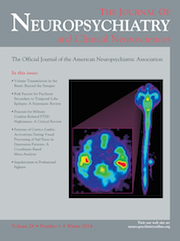Improved Outcomes Using Brain SPECT-Guided Treatment Versus Treatment-as-Usual in Community Psychiatric Outpatients: A Retrospective Case-Control Study
Abstract
Brain single-photon emission computed tomography (SPECT) scans indirectly show functional activity via measurement of regional cerebral blood flow. Thirty patients at a community-based psychiatric clinic underwent brain SPECT scans. Changes in scoring of before-treatment and after-treatment scans correlated well with changes in patient Global Assessment of Functioning (GAF) scores before treatment and after treatment. Patients were retrospectively matched with controls with similar diagnoses and pretreatment GAF scores, and those who underwent SPECT-guided treatment improved significantly more than the control patients.



